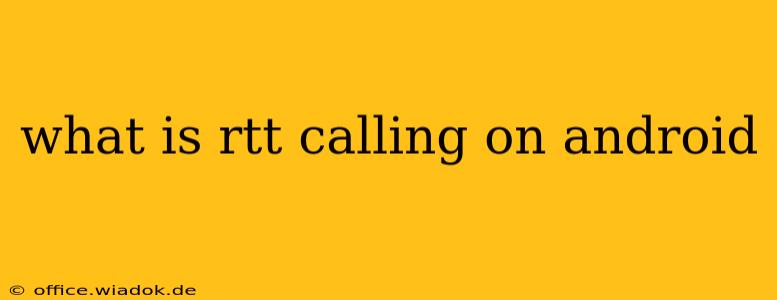Real-time Text (RTT) calling is a revolutionary communication feature for Android devices that allows users to send and receive text messages simultaneously with a voice call. Unlike traditional SMS or instant messaging apps, RTT integrates directly into the phone's calling functionality, providing a seamless and accessible communication experience. This guide delves into the intricacies of RTT calling on Android, exploring its benefits, requirements, and limitations.
Understanding the Benefits of RTT Calling
RTT calling offers a multitude of advantages over standard voice calls, particularly for individuals with hearing impairments or speech difficulties. Here are some key benefits:
-
Simultaneous Text and Voice: Users can simultaneously type and speak during a call. This allows for a richer communication experience, enabling the clarification of ambiguous words or phrases in real-time.
-
Improved Accessibility: RTT significantly improves accessibility for people who are deaf, hard of hearing, or have speech impediments. It offers an alternative communication channel that overcomes the limitations of traditional voice calls.
-
Enhanced Communication Clarity: RTT provides a written record of the conversation, minimizing misunderstandings caused by poor network connectivity, background noise, or speech impediments. This transcribed record can be particularly useful for later reference.
-
Better Call Quality in Noisy Environments: In environments with significant background noise, RTT ensures that the message is clearly transmitted without interference, unlike voice calls which are susceptible to noise.
-
Compatibility with Various Devices: While availability depends on carrier support, RTT is increasingly being incorporated into the latest Android models and is compatible with a wide range of devices.
Requirements for Using RTT Calling on Android
To utilize RTT calling on your Android phone, several conditions must be met:
-
Carrier Support: This is the most crucial requirement. Your mobile carrier must explicitly support RTT calling. Not all carriers offer this service, and availability may vary depending on your location and plan. Contact your carrier to confirm if RTT is available on your plan.
-
Android Version and Device Compatibility: While most modern Android devices support RTT, ensure your device and its operating system version are compatible. Check your device's specifications and Android version details for confirmation. Generally, newer Android versions have better compatibility with RTT.
-
Network Connectivity: A stable and reliable data connection (either Wi-Fi or cellular data) is necessary for RTT calls. While the voice portion might operate on voice over LTE (VoLTE) or similar technologies, the text component usually requires a data connection.
-
Properly Configured Settings: Ensure RTT is correctly enabled in your Android device's settings. The exact steps might vary depending on the device manufacturer and Android version, but generally, it's found within the accessibility or calling settings.
Limitations of RTT Calling
Despite its advantages, RTT calling has certain limitations:
-
Carrier Dependency: The most significant drawback is the dependence on carrier support. If your carrier doesn't offer RTT, you won't be able to use it, even if your device supports it.
-
Not Universally Supported: While adoption is increasing, RTT isn't universally supported across all mobile networks and devices. This can limit its use when communicating with individuals who don't have access to this technology.
-
Data Consumption: RTT calls consume data, so ensure you have a sufficient data allowance to avoid overage charges.
Conclusion: Exploring the Future of Accessible Communication
RTT calling represents a significant leap forward in accessible communication technology for Android users. While limitations regarding carrier support exist, its benefits for individuals with hearing impairments or speech difficulties are undeniable. As adoption grows, RTT will undoubtedly play an increasingly important role in bridging communication gaps and creating a more inclusive digital world. Always check with your carrier to determine availability and compatibility within your region and plan.

